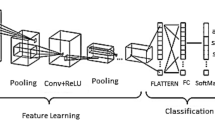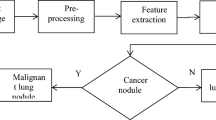Abstract
The second most prevalent and deadly disease in the world is lung cancer. It is become more difficult to detect lung cancer in its early stages in humans. A novel deep learning architecture is suggested in this study to identify lung cancer in its early stages. To distinguish between the diseased and healthy samples, the suggested deep learning structure facilitates in-depth analysis and the creation of superior feature maps. Two independent deep neural network models are combined in the proposed H-DNN (Hybrid deep neural networks) architecture. DNN-1 or SC-SDNN, the first neural network, is used to analyse spatial data, and DNN-2 or CC-FDNN, the second neural network, is used to evaluate frequency data. In order to prevent vanishing gradients, we also added the short connection in the first deep network and the chain connection in the second. Finally, to achieve a better result, we combine both neural networks. The first neural network uses spatial information from the original raw image as its training input, whereas the second neural network uses frequencies generated by wavelets. Our technique outperformed more traditional CNN and SVM classifiers, with a classification accuracy of 98.2%.



















Similar content being viewed by others
Data availability
None.
References
Torre LA, Bray F, Siegel RL, Ferlay J, Lortet-Tieulent J, Jemal A (2015) Global cancer statistics 2012. Cancer J Clin 65:87–108
Firmino M, Morais AH, Mendoça RM, Dantas MR, Hekis HR, Valentim R (2014) Computer-aided detection system for lung cancer in computed tomography scans: review and future prospects. Biomed Eng Online 13:1–16
Suzuki K (2017) Computer-aided detection of lung cancer. In: Image-based computer-assisted radiation therapy. Springer Singapore, Singapore, pp 9–40
El-Baz A, Beache GM, Gimel’farb G, Suzuki K, Okada K, Elnakib A, Soliman A, Abdollahi B (2013) Computer-aided diagnosis systems for lung cancer: challenges and methodologies. Int J Biomed Imaging 942353:1–46
Nishio M, Nagashima C (2017) Computer-aided diagnosis for lung cancer: usefulness of nodule heterogeneity. Acad Radiol 24:328–336
Kawagishi M, Chen B, Furukawa D, Sekiguchi H, Sakai K, Kubo T, Yakami M (2017) A study of computer-aided diagnosis for pulmonary nodule: comparison between classification accuracies using calculated image features and imaging findings annotated by radiologists. Int J CARS 12:767–776
Demir C, Yener B (2005) Automated cancer diagnosis based on histopathological images: a systematic survey. Rensselaer Polytechnic Institute, Tech Rep 5:1–16
Jaffar MA, Hussain A, Nazir M, Mirza AM, Chaudhry A (2008) GA and morphology based automated segmentation of lungs from Ct scan images. In: 2008 international conference on computational intelligence for modelling control & automation. IEEE, Vienna, Austria, pp 265–270
Messay T, Hardie RC, Rogers SK (2010) A new computationally efficient CAD system for pulmonary nodule detection in CT imagery. Med Image Anal 14(3):390–406
Gomathi M, Thangaraj P (2010) A computer aided diagnosis system for lung cancer detection using support vector machine. Am J Appl Sci 7(12):1532
Taher F, Sammouda R (2011) Lung cancer detection by using artificial neural network and fuzzy clustering methods. In: 2011 IEEE GCC conference and exhibition (GCC). IEEE, Dubai, United Arab Emirates, pp 295–298
Hashemi A, Pilevar AH, Rafeh R (2013) Mass detection in lung CT images using region growing segmentation and decision making based on fuzzy inference system and artificial neural network. Int J Image Graph Sign Process 5(6):16
Patz EF, Pinsky P, Gatsonis C, Sicks JD, Kramer BS, Tammemägi MC, Chiles C, Black WC, Aberle DR (2014) Overdiagnosis in low-dose computed tomography screening for lung cancer. JAMA Intern Med 174:269–274
Hua KL, Hsu CH, Hidayati SC, Cheng WH, Chen YJ (2015) Computer-aided classification of lung nodules on computed tomography images via deep learning technique. OncoTargetsTher 8:2015–2022
Kurniawan E, Prajitno P, Soejoko DS (2020) Computer-aided detection of mediastinal lymph nodes using simple architectural convolutional neural network. J Phys Conf Ser 1505(1):012018
Song QZ, Zhao L, Luo XK, Dou XC (2017) Using deep learning for classification of lung nodules on computed tomography images. J Healthc Eng 2017:7
Ciompi F, Chung K, Van Riel SJ, Setio AAA, Gerke PK, Jacobs C, Scholten ET (2017) Towards automatic pulmonary nodule management in lung cancer screening with deep learning. Sci Rep 7:1–11
Gordienko Y, Gang P, Hui J, Zeng W, Kochura Y, Alienin O, Rokovyi O, Stirenko S (2019) Deep learning with lung segmentation and bone shadow exclusion techniques for chest x-ray analysis of lung cancer. Adv Intell Syst Comput 638–647
Shakeel PM, Burhanuddin MA, Desa MI (2019) Lung cancer detection from CT image using improved profuse clustering and deep learning instantaneously trained neural networks. Meas J Int Meas Confed 145:702–712
Ardila D, Kiraly AP, Bharadwaj S, Choi B, Reicher JJ, Peng L, Tse D (2019) End-to-end lung cancer screening with three-dimensional deep learning on low-dose chest computed tomography. Nat Med 25:954–961
Chen S, Han Y, Lin J, Zhao X, Kong P (2020) Pulmonary nodule detection on chest radiographs using balanced convolutional neural network and classic candidate detection. Artif Intell Med 107:101881
Polat H, DanaeiMehr H (2019) Classification of pulmonary CT images by using hybrid 3D-deep convolutional neural network architecture. Appl Sci 9(5):940
Zhao X, Liu L, Qi S, Teng Y, Li J, Qian W (2018) Agile convolutional neural network for pulmonary nodule classification using CT images. Int J Comput Assist Radiol Surg 13(4):585–95
Qin R, Wang Z, Jiang L, Qiao K, Hai J, Chen J, Xu J, Shi D, Yan B (2020) FineGrained lung cancer classification from PET and CT images based on multidimensional attention mechanism. Complexity 2020:1–12
Hosny A, Parmar C, Coroller TP, Grossmann P, Zeleznik R, Kumar A, Bussink J, Gillies RJ, Mak RH, Aerts HJ (2018) Deep learning for lung cancer prognostication: A retrospective multi-cohort radiomics study. PLoS Med 15:1–25
Xu Y, Hosny A, Zeleznik R, Parmar C, Coroller T, Franco I, Mak RH, Aerts HJ (2019) Deep learning predicts lung cancer treatment response from serial medical imaging. Clin Cancer Res 25:3266–3275
Wang S, Dong L, Wang X, Wang X (2020) Classification of pathological types of lung cancer from CT images by deep residual neural networks with transfer learning strategy. Open Med 15(1):190–7
Fang T (2018) A novel computer-aided lung cancer detection method based on transfer learning from googlenet and median intensity projections. In: IEEE international conference on computer and communication engineering technology. IEEE, Beijing, China, pp 286–290
Kumar D, Wong A, Clausi DA (2015) Lung nodule classification using deep features in CT images. In: 2015 12th conference on computer and robot vision. IEEE, Halifax, NS, Canada, pp 133–138
Devi TAM, VI Jose M, Parasuraman PK (2016) A novel approach for automatic detection of non-small cell lung carcinoma in ct images. In: 2016 International conference on control, instrumentation, communication and computational technologies (ICCICCT). IEEE, , Kumaracoil, India, pp 788–792
Jose V, Devi DM (2017) A non invasive computer aided diagnosis system for early detection of lung carcinoma in ct medical images. Int J Latest Trends Eng Technol 8(4):125–130
Sakthi TS, Parasuraman K, Maria Devi A (2016) Implementation of lung cancer nodule features extraction using threshold technique. Int Adv Res J Sci Eng Technol 3(8):29–33
Devi TAM, Benisha S, Mathan Raja M, Kumar P, Senthil Kumar E (2015) Meyer controlled Watershed segmentation on Schistosomiasis in HyperSpectral data analysis. In: 2015 international conference on control, instrumentation, communication and computational technologies (ICCICCT). IEEE, , Kumaracoil, India, pp 829–834
Jeyalakshmi A, Kumar P, Devi AM (2015) Graph cut based method for automatic lung segmentation for tuberculosis by using screening method in chest radiographs. Digit Image Process 7(9):285–291
Janowczyk A, Madabhushi A (2016) Deep learning for digital pathology image analysis: a comprehensive tutorial with selected use cases. J Pathol Inform 7(1):29
Li Z, Hu Z, Xu J, Tan T, Chen H, Duan Z, Liu P (2018) Computer-aided diagnosis of lung carcinoma using deep learning-a pilot study. arXiv preprint, pp 1803.05471
Nayak DR, Dash R, Majhi B (2017) Stationary wavelet transform and AdaBoost with SVM based pathological brain detection in MRI scanning. CNS Neurol Disorders - Drug Targets 16(2):137–149
Zhang Y, Nayak DR, Yang M et al (2017) Detection of unilateral hearing loss by stationary wavelet entropy. CNS Neurol Disorders - Drug Targets 16(2):122–128
Sun W, Zheng B, Qian W (2016) Computer aided lung cancer diagnosis with deep learning algorithms. SPIE Med Imaging 9785:97850Z–97850Z. International Society for Optics and Photonics
de CarvalhoFilho AO, Silva AC, de Paiva AC, Nunes RA, Gattass M (2017) Lung-nodule classification based on computed tomography using taxonomic diversity indexes and an SVM. J Signal Process Syst 87(2):179–96
Author information
Authors and Affiliations
Corresponding author
Ethics declarations
Conflict of interest
The authors declare that there is no conflict of interest and funding.
Additional information
Publisher's Note
Springer Nature remains neutral with regard to jurisdictional claims in published maps and institutional affiliations.
Rights and permissions
Springer Nature or its licensor (e.g. a society or other partner) holds exclusive rights to this article under a publishing agreement with the author(s) or other rightsholder(s); author self-archiving of the accepted manuscript version of this article is solely governed by the terms of such publishing agreement and applicable law.
About this article
Cite this article
Devi, T.A.M., Jose, V.I.M. Skip and chain connected deep fusion network for lung cancer screening. Multimed Tools Appl 83, 39503–39522 (2024). https://doi.org/10.1007/s11042-023-17110-1
Received:
Revised:
Accepted:
Published:
Issue Date:
DOI: https://doi.org/10.1007/s11042-023-17110-1




